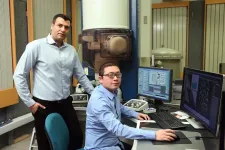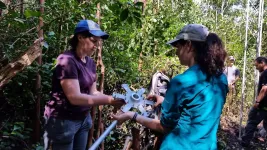(Press-News.org) 'This effort truly represents a "moonshot" in COVID-19 research'
Scientists identify target to treat COVID pneumonia and reduce severity
Clinical trials with new experimental drug to begin early in 2021
Goal is to develop treatments that make COVID-19 no worse than a common cold
First comparison between immune mechanisms driving COVID-19 pneumonia with other pneumonias
CHICAGO --- Bacteria or viruses like influenza that cause pneumonia can spread across large regions of the lung over the course of hours. In the modern intensive care unit, these bacteria or viruses are usually controlled either by antibiotics or by the body's immune system within the first few days of the illness.
But in a study published in Nature on January 11, investigators at Northwestern Medicine show COVID-19 pneumonia is different.
Instead of rapidly infecting large regions of the lung, the virus causing COVID-19 sets up shop in multiple small areas of the lung. It then hijacks the lungs' own immune cells and uses them to spread across the lung over a period of many days or even weeks, like multiple wildfires spreading across a forest. As the infection slowly moves across the lung, it leaves damage in its wake and continuously fuels the fever, low blood pressure and damage to the kidneys, brain, heart and other organs in patients with COVID-19.
The severe complications of COVID-19 compared with other pneumonias might be related to the long course of disease rather than more severe disease, the study authors said.
This is the first study in which scientists analyzed immune cells from the lungs of COVID-19 pneumonia patients in a systematic manner and compared them to cells from patients with pneumonia from other viruses or bacteria.
Drug trial to treat newly discovered targets in COVID-19 pneumonia
As a result of the detailed analysis, researchers identified critical targets to treat severe SARS-CoV-2 pneumonia and lessen its damage. The targets are the immune cells: macrophages and T cells. The study suggests macrophages - cells typically charged with protecting the lung - can be infected by SARS-CoV-2 and can contribute to spreading the infection through the lung.
Northwestern Medicine will test an experimental drug to treat these targets in COVID-19 pneumonia patients in a clinical trial early in 2021. The drug to be tested quiets the inflammatory response of these immune cells, thus enabling initiation of the repair process in the injured lung.
Aim to make COVID-19 like a bad cold
"Our goal is to make COVID-19 mild instead of severe, making it comparable to a bad cold," said study co-senior author Dr. Scott Budinger, chief of pulmonary and critical care medicine at Northwestern University Feinberg School of Medicine and Northwestern Medicine.
"This effort truly represents a 'moonshot' in COVID-19 research," said study co-senior author Dr. Richard Wunderink, professor of pulmonary and critical care medicine at Feinberg and medical director of Northwestern Medicine's ICU.
COVID-19 unlikely to completely disappear
COVID-19, like influenza, is unlikely to ever go away, even if much of the population is vaccinated, said senior co-author Dr. Ben Singer, assistant professor of pulmonary and critical care medicine at Feinberg and a Northwestern Medicine physician.
"Already, researchers at Northwestern and elsewhere are anticipating mechanisms by which this RNA virus, which mutates quickly, will evade current vaccines," Singer said. "This study will help us develop treatments to reduce the severity of COVID-19 in those who develop it."
Mortality in COVID-19 patients on ventilators lower than regular pneumonia patients
The study also revealed why the mortality among patients on a ventilator for COVID-19 was lower than patients on a ventilator due to regular pneumonia, the study reports. An intense conflagration in the lungs (regular pneumonia) has a higher risk of death. Those with COVID-19 pneumonia are sick for a long time, but the inflammation in their lungs is not as severe as regular pneumonia.
"If patients with COVID-19 are carefully managed and the health care system isn't overwhelmed, you can get them through it," Budinger said. "These patients are very sick. It takes a really long time for them to get better. But If you have enough beds and health care providers, you can keep the mortality to 20%. When health systems are overwhelmed mortality rates double up to 40%."
For the study, scientists performed a high-resolution analysis of the lung fluid of 86 COVID-19 patients on a ventilator and compared it with lung fluid from 256 patients on a ventilator who had other types of pneumonia. Because of the safety concerns, only a handful of groups around the world performed analysis of the immune response in the lungs of patients with COVID-19. As a result, important information about what was killing patients with severe COVID-19 was missing.
Northwestern scientists, studying pneumonia for years, poised for COVID lung research
The study performed at Northwestern Medicine is unique because Wunderink and colleagues have been studying pneumonia for years before the pandemic. As a result, when the COVID-19 pandemic hit, they were prepared to collect fluid from the lungs of these patients in a safe and systematic manner and compare it with fluid collected from other ICU patients with pneumonia collected before the pandemic. This research infrastructure allowed them to show that pneumonia in patients with COVID-19 is different from other pneumonia, and more importantly, how it is different.
Scientists took cells from patients' lung fluid and looked at the RNA and the proteins those cells express, enabling them to identify how these immune cells drive inflammation.
"This level of resolution could never be achieved without directly sampling lung fluid," said study co-senior author Dr. Alexander Misharin, an assistant professor of pulmonary and critical care medicine at Feinberg and a Northwestern Medicine physician.
The complex nature of the study, in which samples from patients were analyzed with the most sophisticated technologies available in Northwestern's state-of-the art research labs, required the concerted effort of more than 100 researchers.
INFORMATION:
First authors are Rogan Grant, Luisa Morales-Nebreda and Nikolay Markov. Grant is a graduate student in the Northwestern University Interdepartmental Neuroscience program; Dr. Luisa Morales-Nebreda is a pulmonary and critical care fellow in the Physician Scientist Training Program at Northwestern; Nikolay Markovis is a computational postdoctoral fellow in the division of pulmonary and critical care medicine.
The work was done as part of a consortium of investigators participating in the Successful Clinical Response in Pneumonia Therapy Systems Biology Center funded by the National Institute of Allergy and Infectious Diseases led by Wunderink.
The research was supported by a NUCATS COVID-19 Rapid Response Grant and grants T32AG020506-18, by T32HL076139 and F32HL151127, HL145478, HL147290, HL147575, GM129312, HL134800, U19AI135964, P01AG049665, P01AG04966506S1, R01HL147575, I01CX001777, U19AI135964, P01AG049665, R56HL135124, R01HL153312, K08HL128867, U19AI135964, R01HL149883, and P01AG049665 from the National Institutes of Health. It also was funded by a GlaxoSmithKline Distinguished Scholar in Respiratory Health grant from the CHEST Foundation.
How are networks of neurons connected to make functional circuits? This has been a long standing question in neuroscience. To answer this fundamental question, researchers from Boston Children's Hospital and Harvard Medical School developed a new way to study these circuits and in the process learn more about the connections between them.
"Neural networks are extensive, but the connections between them are really small," says Wei-Chung Allen Lee, PhD, of the F.M. Kirby Neurobiology Center at Boston Children's and Harvard Medical School. "So, we have had to develop techniques to see them in extremely high-resolution over really large areas and volumes." ...
ORLANDO, Jan. 11, 2021 - Data from Arecibo Observatory in Puerto Rico has been used to help detect the first possible hints of low-frequency disturbances in the curvature of space-time.
The results were presented today at the 237th meeting of the American Astronomical Society, which was held virtually, and are published in The Astrophysical Journal Letters. Arecibo Observatory is managed by the University of Central Florida for the National Science Foundation under a cooperative agreement.
The disturbances are known as gravitational waves, which ripple through space as a result of the movement of incredibly massive objects, such as black holes orbiting one another or the collision of neutron stars.
It's important to understand these waves as they provide insight into the history ...
CAMBRIDGE, MA -- When we experience a new event, our brain records a memory of not only what happened, but also the context, including the time and location of the event. A new study from MIT neuroscientists sheds light on how the timing of a memory is encoded in the hippocampus, and suggests that time and space are encoded separately.
In a study of mice, the researchers identified a hippocampal circuit that the animals used to store information about the timing of when they should turn left or right in a maze. When this circuit was blocked, the mice were unable to remember which way they were supposed to turn next. However, disrupting the circuit ...
North Carolina State University-led researchers have developed an analytical measurement "framework" which could allow organic solar cell researchers and manufacturers to determine which materials will produce the most stable solar cells prior to manufacture.
Organic solar cells have increased in efficiency over the past decades, but researchers and manufacturers still struggle with determining which material combinations work best and why, as well as with achieving stable morphology and operation.
"There is still a lot of 'trial and error' guesswork involved in identifying promising materials for these solar cells," says Harald Ade, Goodnight Innovation Distinguished Professor of Physics at NC State and co-corresponding author of the research. ...
Two studies in today's Nature Neuroscience, led by researchers at Boston Children's Hospital, Brigham and Women's Hospital (BWH), and Harvard Medical School (HMS), implicate mosaic mutations arising during embryonic development as a cause of autism spectrum disorder (ASD). The findings open new areas for exploring the genetics of ASD and could eventually inform diagnostic testing.
Mosaic mutations affect only a portion of a person's cells. Rather than being inherited, they arise as a "mistake" introduced when a stem cell divides. A mutation in a stem cell will only be passed to the cells that descend from it, producing the mosaic pattern. ...
Reza Shahbazian-Yassar, professor of mechanical and industrial engineering at the University of Illinois Chicago.
Shahbazian-Yassar and colleagues facilitated the development of a cutting edge "Swiss Army knife" catalyst made up of 10 different elements - each of which on its own has the ability to reduce the combustion temperature of methane - plus oxygen. This unique catalyst can bring the combustion temperature of methane down by about half - from above 1400 degrees Kelvin down to 600 to 700 degrees Kelvin.
Their findings are reported in the journal Nature Catalysis.
In previously-published research, ...
Tales of post-apocalyptic landscapes in which few survivors emerge into a new and much different world have long been popular tales woven by screenwriters and authors. While many enjoy these stories, thinking of them as nothing but a guilty pleasure, they may not realize that immersing themselves in fiction has prepared them for the reality of 2020, according to a team of researchers.
John Johnson, professor emeritus of psychology at Penn State, recently conducted research with several colleagues revealing that an individual's enjoyment of horror films could have better prepared them for the COVID-19 pandemic as opposed to others who do not enjoy frightening entertainment. Their findings are documented in Personality and Individual Differences.
"My latest ...
The first-ever study of the levels of the stress hormone cortisol in the saliva of newborn white-tailed deer fawns yielded thought-provoking results that have Penn State researchers suggesting predation is not the only thing in the wild killing fawns.
"We think the hormone offers a way to evaluate factors in the environment that affect fawns, such as disease, but are difficult to evaluate when just looking at a carcass that has been picked over by predators," said researcher Duane Diefenbach, adjunct professor of wildlife ecology. "By then, it's impossible to be certain what ...
University of Wyoming researchers headed a study that shows nonnative birds in Oahu, Hawaii, have taken over the role of seed dispersal networks on the island, with most of the seeds coming from nonnative plants.
"Hawaii is one of the most altered ecosystems in the world, and we are lucky enough to examine how these nonnative-dominated communities alter important processes, such as seed dispersal," says Corey Tarwater, an assistant professor in the UW Department of Zoology and Physiology. "What we have found is that not only do nonnative species dominate species ...
Boston, Mass. - As the number of COVID-19 infections continues to rise nationwide, more than 360,000 Americans have already died from the potentially deadly viral infection. But recent reports describe an increase in mortality during the pandemic that cannot be explained by COVID-19 deaths alone.
In a new study from the Richard A. and Susan F. Smith Center for Outcomes Research in Cardiology at Beth Israel Deaconess Medical Center (BIDMC), researchers analyzed data from the National Center for Health Statistics to compare the rate of cardiovascular-related deaths before and after the onset of the pandemic in ...



